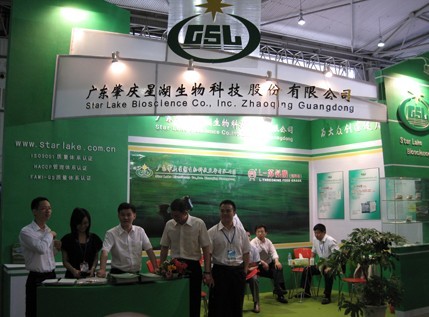On
15 July, 2016, Guangdong Zhaoqing Star Lake Bioscience Co., Inc. (Star Lake
Bioscience) released its H1 2016 financial pre-announcement. The company
predicted its net profit to reach -USD2.71 million (-RMB18 million), vs.
-USD16.24 million (-RMB107.97 million). Despite the improvement, the company
still suffers from losses.

Source: Baidu
“The nucleotide additive market is in
intense competition this year. Our sales prices continue staying low and
therefore, the profitability didn’t get improved,” said Star Lake Bioscience.
As
an established Chinese amino acid producer, Star Lake Bioscience’s performance
has not been so satisfying. Given the fact that the company has been in red for
two consecutive years, in April 2016, it was put an “ST (Special Treatment)”
before its short name “Star Lake” to make a distinction from other stocks,
according to rules formulated by the Shanghai and Shenzhen Stock Exchanges in
1998. Moreover, the “ST” also includes imposing a 5% daily up and down limit
and auditing the company’s financial report.
The
Shanghai and Shenzhen Stock Exchanges will terminate the listing of the stocks
of a listed company if it has been in red for the most recent three consecutive
years. In April this year, Star Lake Bioscience received a Delisting Risk
Warning, saying that its stock may face suspension of listing if the company’s
full-year 2016 audited net profit is still in red, according to the Rules
Governing the Listing of Stocks on Shanghai Stock Exchange. Star Lake
Bioscience is very likely to delist if its H2 performance doesn’t get obvious
improvement.
Star Lake Bioscience's financial performance, 2012-2016 (Q1)

Source: Guangdong Zhaoqing Star Lake Bioscience Co., Inc.

Star
Lake Bioscienceis mainly engaged in the production of nucleotide additives and
feed grade amino acid additives, which are confronted with great challenges.
For instance, despite the fact that the disodium 5'-ribonucleotide in
nucleotide additives has better flavor-enhancing efficacy than monosodium
glutamate, the sales volume of nucleotide additives was merely 2,868 tonnes,
down 49.95% YoY, mainly due to the intense market competition.
In
addition, the company’s fed grade threonine business, with relatively small
production capacity and output, is not so competitive in the market. In 2015,
its sales volume of threonine merely reached 8,112 tonnes, vs. Meihua Holdings
Group Co., Ltd.’s threonine production capacity of 220,00 t/a.
Business
transformation may save the company from delisting risk. In spite of the
serious overall deficit, some of its businesses still enjoy outstanding
profitability, such as the nucleotide API and amino acid API businesses.
According to the company’s full-year 2015 financial report, the gross profit
margin of nucleoside & nucleotide APIs reached +26.13%, vs. -9.91% in
nucleotide additives; that of amino acid APIs achieved +30.9%, vs. -33.63% in
amino acid feed additives. Therefore, Star Lake Bioscience is likely to improve
its financial performance if it invests more into its API businesses.
Star Lake Bioscience's financial
performance by business, 2015

Source: Guangdong
Zhaoqing Star Lake Bioscience Co., Inc.
This
article comes from Amino Acids China E-News 1607, CCM

About
CCM:
CCM
is the leading market intelligence provider for China’s agriculture, chemicals,
food & ingredients and life science markets. Founded in 2001, CCM
offers a range of data and content solutions, from price and trade data to
industry newsletters and customized market research reports. Our clients include
Monsanto, DuPont, Shell, Bayer, and Syngenta. CCM is a brand of Kcomber Inc.
For
more information about CCM, please visit www.cnchemicals.com or
get in touch with us directly by emailing econtact@cnchemicals.com or
calling +86-20-37616606.
Tag: amino acid